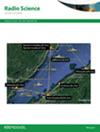Land cover recognition from few samples of radar high-resolution range profile
IF 1.5
4区 地球科学
Q3 ASTRONOMY & ASTROPHYSICS
引用次数: 0
Abstract
Radar echo data, a refined representation of detected targets, is gaining attention in electronic warfare, marine environment monitoring, and agriculture intelligence for land cover recognition. In contrast to prevailing studies involving two-dimensional images such as synthetic aperture radar (SAR) or inverse SAR (ISAR) images, one-dimensional High-Resolution Range Profile (HRRP) data offers advantages of easy access and simple processing. Nonetheless, its potential application has yet to be explored, as current research on it remains insufficient. Meanwhile, deep learning methods that specialize in classification tasks but encounter challenges in modern electronic warfare, given their heavy reliance on the number of labeled samples. To tackle these issues, a feature fusion-based land cover recognition approach is proposed, which introduces Convolutional Embedding Sequence Encoder (CE-SE) to capture the complex clutter characteristics of HRRP, achieving land cover recognition with a small number of labeled HRRP samples and eliminating the reliance on two-dimensional image data. Experimental results validated on Mini-SAR data from unmanned aerial vehicles demonstrate effective land cover recognition using HRRP. This method significantly improves the recognition accuracy for five land cover types, exceeding 92%, even with only half the sample size compared to traditional deep learning methods. Additionally, the model's inference time for a single HRRP sample is just 1.3 milliseconds, demonstrating its capability for real-time land cover recognition.基于少量雷达高分辨率距离像样本的土地覆盖识别
雷达回波数据,一种被探测目标的精确表示,在电子战、海洋环境监测和用于陆地覆盖识别的农业情报中得到越来越多的关注。与目前研究的二维图像(如合成孔径雷达(SAR)或逆SAR (ISAR)图像)相比,一维高分辨率距离像(HRRP)数据具有易于获取和简单处理的优点。然而,其潜在的应用还有待探索,因为目前对其的研究仍然不足。与此同时,深度学习方法专注于分类任务,但在现代电子战中遇到挑战,因为它们严重依赖于标记样本的数量。为了解决这些问题,提出了一种基于特征融合的土地覆盖识别方法,该方法引入卷积嵌入序列编码器(CE-SE)来捕捉HRRP的复杂杂波特征,利用少量标记的HRRP样本实现土地覆盖识别,消除了对二维图像数据的依赖。在无人机Mini-SAR数据上验证的实验结果表明,HRRP方法对土地覆盖识别是有效的。与传统深度学习方法相比,该方法在样本量只有一半的情况下,显著提高了五种土地覆盖类型的识别准确率,超过92%。此外,该模型对单个HRRP样本的推断时间仅为1.3毫秒,证明了其实时土地覆盖识别的能力。
本文章由计算机程序翻译,如有差异,请以英文原文为准。
求助全文
约1分钟内获得全文
求助全文
来源期刊

Radio Science
工程技术-地球化学与地球物理
CiteScore
3.30
自引率
12.50%
发文量
112
审稿时长
1 months
期刊介绍:
Radio Science (RDS) publishes original scientific contributions on radio-frequency electromagnetic-propagation and its applications. Contributions covering measurement, modelling, prediction and forecasting techniques pertinent to fields and waves - including antennas, signals and systems, the terrestrial and space environment and radio propagation problems in radio astronomy - are welcome. Contributions may address propagation through, interaction with, and remote sensing of structures, geophysical media, plasmas, and materials, as well as the application of radio frequency electromagnetic techniques to remote sensing of the Earth and other bodies in the solar system.
 求助内容:
求助内容: 应助结果提醒方式:
应助结果提醒方式:


